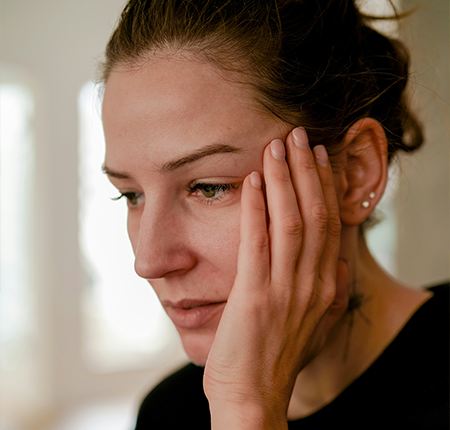
Normally, a healthy menstrual cycle lasts between 21 and 35 days. But what happens when you have more than 35 days between periods, when your bleeding is unusually light, and you have fewer than 9 periods in an entire year?
All of these can be signs of oligomenorrhea, a menstrual disorder that can be of several types and that can affect your fertility. In this article, we explain exactly what this means, why it happens, what types of oligomenorrhea there are, and how it can be treated.
What is oligomenorrhea (infrequent menstruation)?
Oligomenorrhea is a menstrual disorder characterized by light bleeding and reduced frequency. Menstruation occurs infrequently (hence the name), at irregular intervals exceeding 35 days, and is very light in quantity.
What is the difference between oligomenorrhea and amenorrhea?
Both oligomenorrhea and amenorrhea are disorders related to the frequency of menstrual bleeding, but there is an important difference between the two.
Women who suffer from oligomenorrhea have infrequent, irregular periods, usually less than 9 periods in a year, but these periods still exist.
In contrast, amenorrhea is characterized by the total absence of menstruation for 6 consecutive months or more.
How common is oligomenorrhea?
Approximately 12% to 15.3% of menstruating women experience oligomenorrhea at some point. Of those with fertility problems, approximately 20% suffer from oligomenorrhea.
Oligomenorrhea is also often associated with polycystic ovary syndrome (PCOS). Statistics estimate that 75% to 85% of patients with PCOS also have infrequent periods.
Types of oligomenorrhea
Depending on the causes and characteristics, whether hormonal or not, we can distinguish several types of oligomenorrhea. Below we explain what each one means.
Hypogonadotropic oligomenorrhea
Hypogonadotropic oligomenorrhea refers to infrequent menstruation caused by a deficiency in luteinizing hormone (LH) and follicle-stimulating hormone (FSH). Anti-mullerian hormone (AMH) levels remain normal in this type of oligomenorrhea.
In short, the brain does not send the proper signals for the ovaries to stimulate ovulation and menstruation. Hypogonadotropic oligomenorrhea is found in women with late puberty, anorexia, bulimia, chronic stress, those who practice intense physical exertion, and those who suffer from the athlete's triad or hyperprolactinemia.
Oligomenorrhea hypergonadotropic
Hypergonadotropic oligomenorrhea defines infrequent menstruation accompanied by very high levels of luteinizing hormone (LH) and follicle-stimulating hormone (FSH), but with low levels of anti-mullerian hormone (AMH).
These values indicate a problem with ovarian function, and are usually found in menopausal women, patients with Turner syndrome, and those who have undergone various treatments (e.g. chemotherapy, pelvic radiotherapy, treatment to remove the ovaries).
Dysgonadotropic oligomenorrhea
In dysgonadotropic oligomenorrhea, luteinizing hormone and follicle-stimulating hormone levels are normal or slightly altered, but an abnormal ovarian response still occurs. This type of disorder is specific to patients with PCOS (polycystic ovary syndrome).
Iatrogenic oligomenorrhea
Iatrogenic oligomenorrhea is triggered by complications after surgery or as a side effect of treatments. It is characterized by infrequent menstruation after removal of the ovaries or uterus, after radiation or chemotherapy treatments, or other treatments that affect the hormonal axis.

Causes of oligomenorrhea
Hormonal disorders are the most common (but not the only) cause of infrequent periods. When there is an imbalance in the hormones produced by the reproductive glands and organs, it affects the regularity of the menstrual cycle and can cause oligomenorrhea. The most common causes include:
- Puberty : It is normal for the first few years after the onset of menstruation, when hormone levels are still fluctuating greatly, to have irregular periods. But if oligomenorrhea persists for 3-4 months or turns into amenorrhea (complete absence of menstruation for 6 months), even at puberty, it may be an early sign of polycystic ovary syndrome, Turner syndrome or adrenal hyperplasia.
- Hormonal imbalances : When such an imbalance occurs, the hormones that control ovulation and the menstrual cycle no longer function properly, affecting the flow and frequency of menstruation.
- Stress : the body secretes an increased amount of cortisol during stressful periods, which can also be accompanied by increased insulin resistance and can affect the rhythm of the menstrual cycle.
- Polycystic ovary syndrome : PCOS leads to excess production of androgen hormones (such as testosterone), which can prevent ovulation and lead to irregular periods.
- Bulimia/Anorexia: Hormonal balance can be thrown off balance by hormonal fluctuations, which can prevent normal ovarian function and endometrial development.
- Adrenal gland hyperplasia: is characterized by excess production of adrenal hormones, which inhibit the production of luteinizing hormone and follicle-stimulating hormone and affect the menstrual rhythm.
- Thyroid gland disorders: oligomenorrhea can be caused by both hypothyroidism and hyperthyroidism.
- Diabetes: There are studies that associate oligomenorrhea with type 1 diabetes, common in underweight people, and type 2 diabetes, found in overweight people.
- Perimenopause : in the absence of other causes to explain the infrequent menstruation, oligomenorrhea may be an early sign of menopause.
Symptoms associated with oligomenorrhea
Oligomenorrhea itself is a symptom of any of the conditions explained above. The most common and obvious symptom is the delay or absence of menstruation for periods longer than 35 days.
But in turn, the disorder may also be accompanied by other signs, including:
- Mild abdominal pain
- Acne
- Weight gain
- Hair loss or excess body hair
- Infertility, in some cases
- Headaches
- Vaginal discharge
- Hot flushes
- Vision problems
Oligomenorrhea - How to diagnose
The diagnosis of oligomenorrhea is made by the gynecologist, based on the medical history and additional investigations:
- Anamnesis: consists of a discussion with the patient and questions regarding the flow, regularity of the menstrual cycle and other relevant symptoms. Also within the anamnesis, the doctor can find out what lifestyle the patient has, if she suffers from chronic stress, if she is approaching menopause, if she practices performance sports or has undergone certain treatments and surgeries.
- Physical examination: together with the history, the physical examination (face, breasts, body) allows observation of associated symptoms such as acne and weight loss or gain.
- Gynecological exam: Allows the doctor to examine the vagina and cervix to see if there are any signs of inflammation, infection, bleeding, or scar tissue that may affect the menstrual cycle.
- Pelvic ultrasound: allows the identification of polycystic or atrophic ovaries, or other abnormalities in the uterus and endometrium, which could be associated with oligomenorrhea.
Hormonal tests: Blood tests measure levels of luteinizing hormone, follicle-stimulating hormone, anti-mullerian hormone, estrogen, progesterone, testosterone, prolactin, thyroid hormones, and any other relevant hormones that may influence menstrual cycle regularity. The results also allow for identification of the type of oligomenorrhea.

Oligomenorrhea - Treatment Options
The first step in determining treatment is to correctly and accurately identify the cause. Treatment for oligomenorrhea varies depending on the underlying problem, and may include hormone therapies, surgery, or simply lifestyle changes.
Hormone therapy
If oligomenorrhea is due to a hormonal imbalance, the doctor may prescribe various hormonal treatments. These may include contraceptives, estrogen, progesterone, antiandrogens, dopamine antagonists, specific supplements, and other types of hormonal therapy, depending on the cause.
Lifestyle changes
If oligomenorrhea is a consequence of chronic stress, excessive physical exertion, or conditions such as PCOS, your doctor may recommend certain lifestyle changes. These generally involve giving up high-performance sports, psychological counseling, and prioritizing rest and a nutritious diet.
Surgical intervention
Surgery is recommended when there is a tumor that stimulates excess production of androgen hormones. The goal of treatment is to remove the tumor to restore hormonal balance, and automatically regulate the menstrual cycle.
Frequently asked questions about oligomenorrhea
It's important to understand that, like menstruation itself, oligomenorrhea can look different for each woman, and its impact on health and daily life depends on the causes and context. Below, we've answered the most frequently asked questions about this menstrual disorder, in the hope that we'll help you understand it better and know when to seek medical help.

How dangerous is oligomenorrhea?
Oligomenorrhea itself is not dangerous, but it can signal a hormonal imbalance or condition that requires treatment, especially if it persists. If suddenly, your periods start to be delayed for more than 35 days and come with a very light flow, or if you have fewer than 9 periods in a year, make a visit to your gynecologist for further investigations.
Is oligomenorrhea normal during adolescence?/
Yes, irregular and infrequent periods are common and normal in the first few years after the onset of menstruation, due to hormonal fluctuations. However, if your periods still do not regulate after 3-4 years, a gynecological consultation is recommended.
Does oligomenorrhea affect fertility?
Yes, oligomenorrhea can affect fertility. Irregular menstrual cycles can indicate a lack of ovulation, which is necessary for conception, so it is important to monitor your cycle and discuss these issues with your gynecologist if you are unable to get pregnant.
Can stress cause infrequent menstrual cycles?
Yes, stress can stimulate increased cortisol levels in the body and can even interact with the hormones that control ovulation, causing delayed or absent menstruation.
Can oligomenorrhea occur after pregnancy?
Yes, your menstrual cycle may remain irregular in the postpartum period, especially while breastfeeding, because prolactin (the hormone that stimulates lactation) can temporarily suppress ovulation.
Usually, menstruation gradually returns to normal a few months after childbirth or after stopping breastfeeding. However, if oligomenorrhea persists for a long time or turns into amenorrhea, medical consultation is recommended.
Can contraceptives cause oligomenorrhea?
Yes, birth control pills affect your menstrual cycle and can cause unpredictable, light, or light bleeding if you stop or change your treatment. Your body needs time to restore hormonal balance and regulate your menstrual cycle, which can lead to temporary oligomenorrhea. If oligomenorrhea persists, whether with or without birth control pills, it is a good idea to consult a doctor.
Photo credit: Pexels.com & Unsplash.com






















